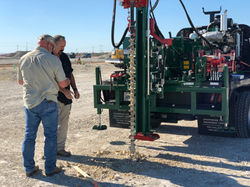
DRILLING & SAMPLING
 rigDescribe your image. |  backhoeDescribe your image. |
|---|---|
 Rig and usDescribe your image. |  3130ea0e3d3012e1179d551eb9ba1f25Describe your image. |
 JEEPDescribe your image. |  EXCEVATEDescribe your image. |
To obtain information about the soil conditions below the surface, some form of subsurface exploration is required. Methods of observing the soils below the surface, obtaining samples, and determining physical properties of the soils and rocks include are described below.
SPLIT SPOON
Split-spoon / SPT Sampler. Utilized in the 'Standard Test Method for Standard Penetration Test (SPT) and Split-Barrel Sampling of Soils. It is driven into the ground with a 140-pound hammer falling 30". The blow counts (hammer strikes) required to advance the sampler a total of 18" are counted and reported. Generally used for non-cohesive soils, samples taken this way are considered disturbed.


SHELBY TUBE
Shelby Tube Sampler. Utilized in the 'Standard Practice for Thin-Walled Tube Sampling of Soils for Geotechnical Purposes. This sampler consists of a thin-walled tube with a cutting edge at the toe. Generally used in cohesive soil. Soil sampled in this manner is considered undisturbed.
AUGER
Auger borings often provide the simplest method of soil exploration and sampling. They may be used for any purpose where disturbed samples can be used and are valuable in connection with groundwater level determination and indication of changes in strata and advancement of hole for split-barrel penetration tests and sampling and thin-walled tube sampling. Depths of auger explorations are, however, limited by groundwater conditions, soil characteristics.


TEST PITS
Test Pit Sampling Procedure. Exploration pits and trenches permit detailed examination of the soil and rock conditions at shallow depths and relatively low cost. Exploration pits can be an important part of geotechnical explorations where significant variations in soil conditions occur (vertically and horizontally), large soil and/or non-soil materials exist (boulders, cobbles, debris) that cannot be sampled with conventional methods, or buried features must be identified and/or measured.

DISTURBED SAMPLES
Disturbed samples are those obtained using equipment that destroy the macro structure of the soil but do not alter its mineralogical composition. Specimens from these samples can be used for determining the general lithology of soil deposits, for identification of soil components and general classification purposes, for determining grain size, Atterberg limits, and compaction characteristics of soils.

UNDISTURBED SAMPLES
Undisturbed samples are obtained in clay soil strata for use in laboratory testing to determine the engineering properties of those soils. It should be noted that the term “undisturbed” soil sample refers to the relative degree of disturbance to the soil’s in-situ properties. Undisturbed samples are obtained with specialized equipment designed to minimize the disturbance to the in-situ structure and moisture content of the soils. Specimens obtained by undisturbed sampling methods are used to determine the strength, stratification, permeability, density, consolidation, dynamic properties, and other engineering characteristics of soils.